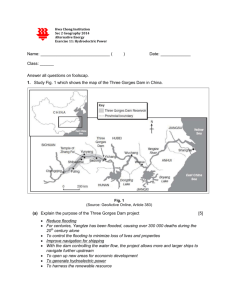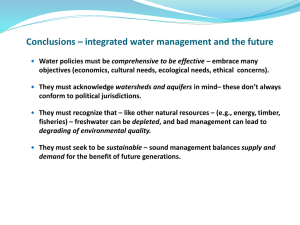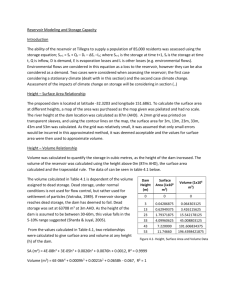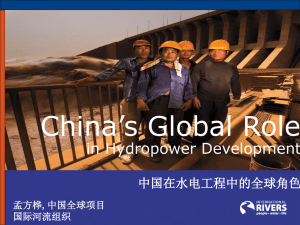Three Gorges Project
advertisement
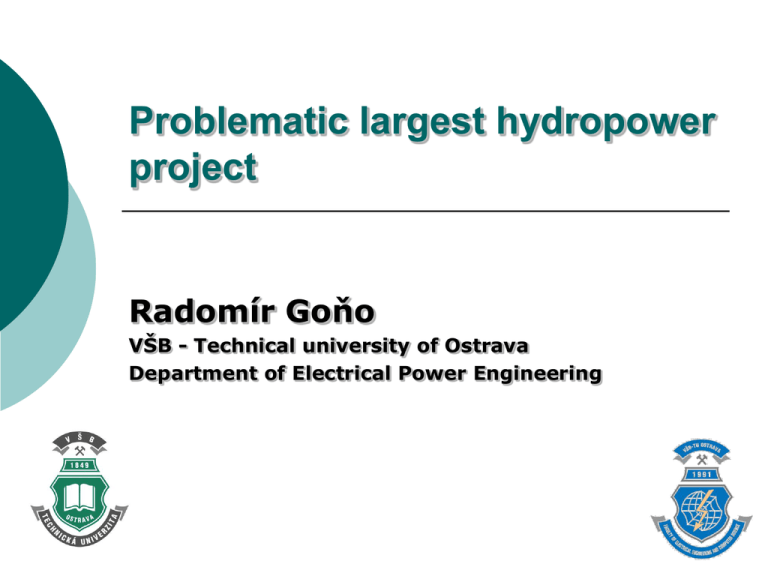
Problematic largest hydropower project Radomír Goňo VŠB - Technical university of Ostrava Department of Electrical Power Engineering Introduction The Three Gorges Dam The Three Gorges Dam The Three Gorges Dam Comparison of giants The Three Gorges Dam, Yangtze river in China Comparison of giants Water power plant Itaipu Binational, Parana river, Brazil and Paraguay Comparison of giants Parameters Itaipu Three Gorges Number of turbines 20 Francis (700MW) 32 Francis (700MW) Turbine diameter (m) 8.6 9.7 Maximum power (GW) 14 22.4 Electricity generation (TWh/year) 93 100 Discharge capacity (m3/s) 62,200 102,500 Reservoir length (km) 170 600 Reservoir surface area (km2) 1,350 1,084 Dam wall length (m) 7,700 2,309 Dam wall elevation (m) 196 181 Relocation of residents (mil.) 4 1.24 Project History 1919 - the dam was originally envisioned 1932 - Nationalist government (Chiang Kai-shek), preliminary work on plans 1939 - Japanese military forces occupied Yichang and surveyed the area, Otani plan, was completed 1944 - involvement from the United States 1949 - communist victory, Mao Zedong supported the project, but the Gezhouba Dam was begun first 1980s - plans were revived 1992 - dam was approved by the National People's Congress 1994-12-14 - the construction started 2003 - the first generator started working 2008 - the last main generator was completed dam is expected to become fully operational until 2011 Project Scale and Economics The dam body was divided into the left side, the spill way, and the right side The underground power plant under construction is hidden in the mountains Dam wall The project used 27,200,000 m3 of concrete, 463,000 t of steel, and moved about 102,600,000 m3 of earth The reservoir created by the TGD made of concrete 2,309 m long 181 m high 115 m thick on the bottom 40 m thick on top 660 km in length 1.12 km in width on average contains 39.3 km3 of water surface area 1,045 km² flooded 632 km² of land cost 180 billion yuan will be recovered when the dam has generated 1,000 TWh of electricity - 10 years after the dam starts full operation Electricity Generation total capacity 22,500 MW 34 generators 32 main, 700 MW each 2 plant power generators, 50 MW each annual electricity generation 100 TWh generators weighs 6,000 t flow rate between 600 m3/s and 950 m3/s Francis turbines diameter of each turbine is 9.7/10.4 m (VGS design/Alstom's design) speed 75 rpm Electricity Generation Electricity Generation Generator normal rated power 778 MVA maximum power 840 MVA power factor 0.9 voltage 20 kV stator outer diameter 21.4/20.9 m stator inner diameter 18.5/18.8 m stator height 3.1/3 m the biggest stator in the world load 5050/5500 t average efficiency of the generators is over 94%, and the highest is 96.5%. Electricity Generation Rotor Power Distribution 500 kV DC transmission lines 7,200 MW 500 kV AC transmission lines 12,000 MW. 500 kV DC transmission line 3,000 MW TGP was expected to provide 10% of the electricity consumed in China. However, China’s demand for electricity has increased at a higher rate than was planned; if it were fully operational now, it would support only about 3% of China's total electricity consumption Power Distribution Transformer Operation Yangtze River flow Contributions Reduction of Emission reduction the coal consumption by 31 million t/year 100 million t of greenhouse gas millions t of dust one million t of sulfur dioxide 370,000 t of nitric oxide 10,000 t of carbon monoxide significant amount of mercury transport about 31 million t of coal Contributions Waste Management 50 waste-water treatment plants had been installed 65% of the waste water is treated 32 deposition land sites were completed Flood Control and Drought Relief flood storage capacity is 22 km3 (100 years) discharges its reservoir during the dry season water level upstream drops from 175 m to 145 m Contributions Navigation ship locks two ship locks is made up of five stages four hours in total to transit vessel capacity of 10,000 t locks are 280 m long, 35 m wide and 5 m deep increase river shipping from ten million to 100 million t annually transportation costs cut by 30% shipping is safer freight capacity of the river increased six times cost of shipping was reduced by 25% ship lift lifting ships of up to 3,000 t vertical distance 113 m, size of the ship lift's basin is 120x18x3.5 m the ship lift will take 40 minutes ship lift had to be designed to work properly even if the water levels varied by 12 m on the lower side, and 30 m on the upper side construction started in 2007 and will be completed in 2014 Problematic Issues water quality detriments to wildlife potential riverbank collapses potential silt related falling of coastal areas Problematic Issues Relocation of Residents Affecting Biodiversity 1.24 million residents was relocated endangered Siberian Crane extinction of Yangtze river dolphin high levels of pollution in the Yangtze Effect on Local Culture reservoir has flooded some 1,300 archaeological sites cultural and historical relics are being moved but some were flooded Problematic Issues Erosion and Sedimentation the dam sits on a seismic fault (?) 80% of the land is experiencing erosion - 40 million tons of sediment annually silt in the reservoir reduce silt in the Yangtze Delta reduce the effectiveness of electricity generation the lack of silt deposited in the peninsula could result in erosion and sinking of coastal areas downstream riverbanks more vulnerable to flooding the less sediments the more vulnerable is Shanghai to inundation Problematic Issues National Security Structural Integrity high-value target after the first filling of the reservoir, 80 visible cracks were observed Earthquakes and Landslides potential for earthquake-induced peak ground acceleration coupled with the immense weight of the reservoir water, could cause breaching erosion, induced by rising water, causes frequent major landslides that have led to noticeable disturbance in the reservoir surface Problematic Issues Damming Projects Upstream - China plans to build a series of dams maximize the utility of the TGD cut down on sedimentation capacity of four dams is 38,500 MW Problematic Issues New plans 38.5 GW Questions? Thank you for your attention.

